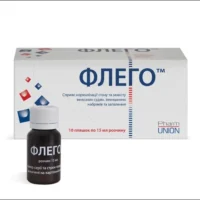Description
Escuvit 25 ml. Vial
Composition
Escuvit 25 ml. Vial contains Vitamin C (Ascorbic Acid) as the active ingredient.
Mechanism of Action
Vitamin C functions as an essential cofactor for numerous enzymatic reactions in the body, playing a pivotal role in collagen synthesis, neurotransmitter production, and antioxidant defense mechanisms.
Pharmacological Properties
The pharmacological properties of Escuvit 25 ml. Vial stem from the antioxidant activity of Vitamin C, which scavenges free radicals, thereby protecting cells from oxidative damage and contributing to overall cellular health.
Indications for Use
Escuvit 25 ml. Vial is indicated for the prevention and treatment of Vitamin C deficiency, which may manifest as symptoms such as fatigue, weakened immunity, and impaired wound healing.
Contraindications
Use of Escuvit 25 ml. Vial is contraindicated in individuals with a history of hypersensitivity to Vitamin C or any other components present in the formulation.
Side Effects
Common side effects associated with Vitamin C supplementation may include gastrointestinal disturbances such as nausea, diarrhea, and abdominal cramps. In rare cases, allergic reactions like rash or itching may occur.
Usage Instructions
For optimal results, Escuvit 25 ml. Vial is typically administered intravenously after appropriate dilution. The recommended dosage regimen involves the administration of one vial per day under the supervision of a healthcare provider.
Benefits over Analogues
Compared to traditional oral Vitamin C supplements, Escuvit 25 ml. Vial offers a more direct and efficient route of administration, ensuring rapid absorption and bioavailability. This intravenous delivery method is particularly advantageous for individuals with compromised gastrointestinal absorption.
Suitable Patient Groups
Escuvit 25 ml. Vial is suitable for a wide range of patient populations, including children, elderly individuals, and patients with malabsorption issues who may benefit from the enhanced absorption profile of intravenous Vitamin C supplementation.
Storage and Shelf Life
It is imperative to store Escuvit 25 ml. Vial in a cool, dry place away from direct sunlight to maintain product stability. Ensure that the vial is kept out of the reach of children. The product should be used before the expiration date indicated on the packaging.
Packaging Description
The Escuvit 25 ml. Vial is presented in a sterile glass vial containing 25 ml of the solution for intravenous administration. The packaging is designed to maintain product integrity and sterility until use.
Clinical Evidence and Effectiveness
Scientific studies have underscored the critical role of Vitamin C in supporting immune function and reducing the duration of common cold symptoms. Clinical trials have demonstrated the cardiovascular benefits of Vitamin C supplementation, emphasizing its potential in reducing the risk of chronic diseases.





